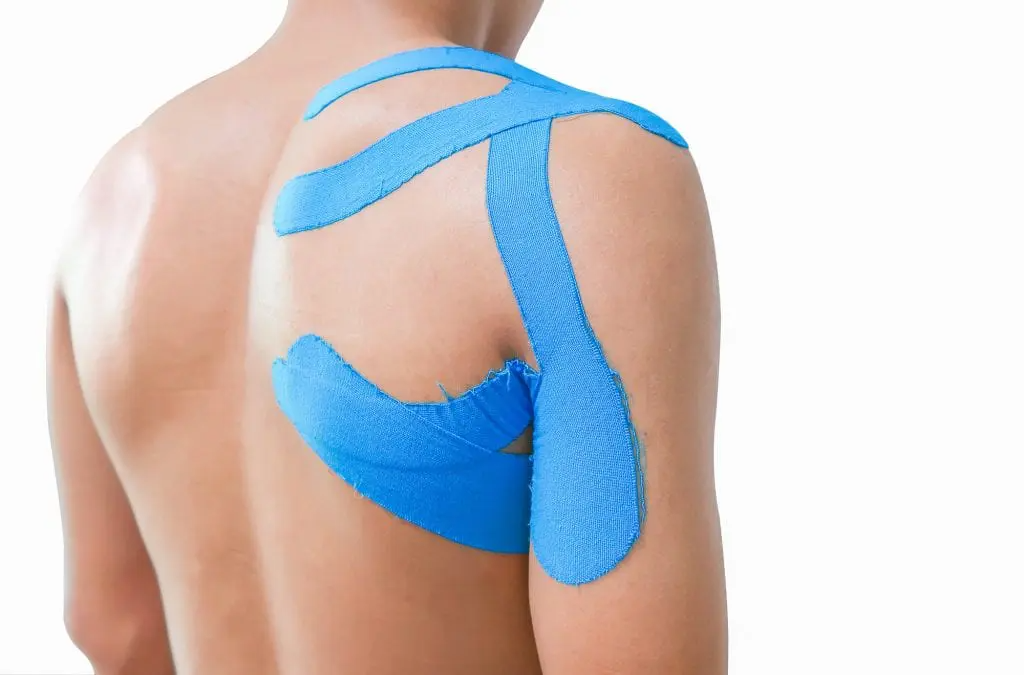You know that weird tape you see on people who have sprained ankles or torn muscles? Yeah, that’s kinesio tape. It might look useless, but this tape actually is working harder than you think. Curious? You should be. After all, it can really save your back, knee, leg, or… Well, you get the picture. Read on to see the what, why, how and when of this strange anomaly that plagues physical therapist offices and finds out once and for all the answer to the question on your mind: What does kinesio tape do?
What Is It?
Kenesio tape is utilized in physical therapy. It aids the body’s natural healing process by supporting muscles and joints. The stiff cotton is interlaced with polymer elastic strands that permit mobility. Like regular athletic tape, it stabilizes or immobilizes the injured part but has the added benefit of lifting the epidermis up, allowing extra blood flow. It was invented in the 1970s by Dr. Kenzo Kase when he was searching for a surgery-free answer to relieving pain. Today, the tape is widely used in the Olympics by professional athletes who desire mobility without the risk of further injury. In fact, Lance Armstrong said its healing properties were akin to “magical powers.”
What Does Kinesio Tape Do?
In youths alone, there are 1.35 million sports injuries per year. The severity of the damages in each case ranges from a sprained ankle to head injuries, but suffice it to say that sports injuries are common occurrences across the globe. Many of these injuries can be alleviated with kinesio tape. The tape’s name refers to kinesiology, the study of the science behind the muscular and skeletal systems’ movement. Pain derives from sensors between the epidermis and dermis. By lifting the topmost layer away from the one below it, blood flow increases. Because of this, the blood can travel freely around the affected tissue and muscle. It also increases lymphatic drainage, a common technique used in massages that speed up cell and tissue regeneration. The end result is less pain and a quicker route to a healed body. In keeping the muscles activated, improving circulation and reducing pain the healing process is quickened.
Benefits
The science behind these bandages lead to several health benefits:
- The muscle is supported, discouraging further injury and protecting it from cramping, strains, and over-contraction
- Inflammation is reduced
- The healing process is intensified
- Chemical buildup from slow circulation is negated
- Misaligned joints are readjusted
- The individual’s range of motion is not inhibited
It also increases proprioception, oftentimes referred to as the body’s “sixth sense.” The fact that we can close our eyes and touch our noses or drink from a straw is due to proprioception. Within each muscle in the body are muscle spindles. They are surrounded by sensory nerve fibers, making these parts specialize in sensations. These nerve fibers send information to the brain, telling it where your body is and where it is headed. (So, yes, next time you stab your nose with a straw instead of putting it in your mouth you can blame proprioception.) With kinesio tape, the tactile pressure stimulates the muscles all day, increasing your sixth sense.
When Can It Be Used?
The tape is used for a variety of ailments.
- To relax overworked muscles
- To prevent overexertion of muscles
- To relieve pain
- To enhance performance
- To help a sprain, tear or overworked muscle heal
- For relief in chronically injured or weak muscles
It’s even used by pregnant women to reduce back pain.
Does It Really Work?
There has been much debate over whether or not kinetic taping works. At best, studies have had mixed results.
Claims the Tape Does Not Work
Some claim the positive benefits have more to do with a placebo effect than actual science. In fact, in 2012 the Advertising Standards Authority ordered a company to stop making exaggerated claims about the tape’s effectiveness. In one study published in 2015, researchers blindfolded 30 participants and applied three different tapes to the participants’ quadriceps. Researchers then measured peak torque (how much the muscle was pulling or pushing) during weight training exercises. According to the study, there was no difference between the performances of all individuals.
Claims the Tape May Work
Another study published in 2012 examined several types of injuries, including musculoskeletal injuries in the lower extremity and the spine as well as injuries associated with whiplash. The study indicated that, while the tape’s long-term effectiveness may be debatable, there was evidence it does alleviate short-term pain. In yet another instance, researchers applied kinetic taping to 26 adults who had sprained ankles. Joint position sense (proprioception) was improved in two different positions after the tape was applied.
What Many Forget
However, what most people forget is that kinesio is a tape, and science, as well as physicians across the globe, agree that taping does work. Different types of tape do everything kinesio tape does, but they simply lack the mobility allowed with kinesio taping. This makes kinesio taping more useful, especially in physical therapy. But no one can deny the countless athletes and individuals who claim, without any hint of a doubt, that the tape works for them. Perhaps, then, we can conclude this: kinesio tape is beneficial, it certainly works, it’s more comfortable, and it lasts several days–but it may or may not work better than other tapes.
Can I Use K-Tape Myself?
Absolutely! However, it’s best to get the help of a physician first.
While it is highly improbable you will harm yourself if you apply the tape on your own, you may not be helping your body, either. The doctors at Premier Physical Therapy are trained to find the best methods to fit your individual needs. If you have any type of injury, they can assess it and show you how to apply kinesio tape for the best results. We’ve covered a lot of information, but it all comes down to this: What does kinesio tape do? It does a whole lot of things, but two things are certain: it really can alleviate pain and get you back to your daily routine.
.png)



